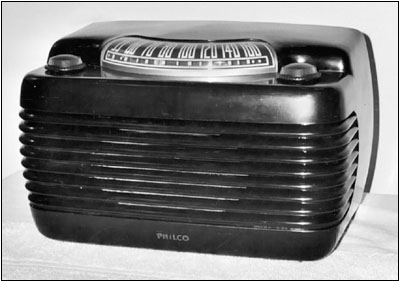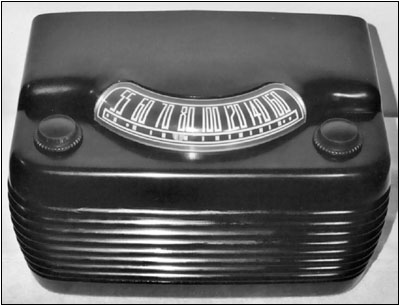Of Old Radios And Related Items--Published Monthly
Philco Model 48-460
BY RICHARD ARNOLD
Web edition
Along the Oklahoma radio trail, Richard Arnold seems to have good luck finding sets of interest at reasonable prices. Here's another of his "finds." (Editor)
For six months or so, I had been watching a Philco 46-420 at an antique store here in Ardmore, Oklahoma. It is a look-alike radio to the Philco 48-460 that this article features. The owner had a firm selling price of $79, which I thought was a little too much, and I was hoping that the price would come down. I finally made up my mind to ask the antique store owner to call the owner to see if he would come down to about $40. Just as I was about to ask him to make the call, he said, "I have a radio that you might be interested in out back in my storage area."
When we got back there, he showed me a Bakelite radio he had on a table. It was the 48-460, shown in Figure 1. It was in pretty good condition, and it played. I asked him how much he wanted for it, and he said, "Gimmie $20." So, now I had a 48-460 that looked exactly like the 46-420 that I had come down to the store to try to purchase.

Figure 1. The Philco Model 48-460.Since then I have been doing some research and have found out that these two sets that look alike are actually different in chassis design. Both are 6-tube radios, but the difference is that the 46-420 has an RF amp and a single IF, while the 48-460 has no RF amp but has two IFs.
The Model 48-460
The Philco Service Notes provide the following information about the Models 48-460 and 48-460-I (the "I" meaning an ivory color cabinet): these two sets are 6-tube, table model, superheterodyne radios, providing reception in the standard broadcast band (540-1620 Kc). The high-impedance loop aerial normally provides adequate signal pickup. If greater pickup is required, an external aerial may be connected. The loop works into a 14AF7 converter. Variable condenser tuning is used.
The two IF stages employ 7B7 pentode tubes. To obtain good stability, resistance coupling is employed between the first and second IF tubes. One diode (pin 5) of the 7C6 tube provides detection and AVC voltage. The triode section of this tube functions as the first audio amplifier and is resistance coupled to the Type 50L6GT-output tube. The speaker is a permanent magnet dynamic. The power supply employs a Type 35Y4 tube working into a resistance capacitance filter system. The IF is 455 Kc.

Figure 2. A top view showing the controls and curved tuning scale.The Model 46-420 uses the following tube types: 7A8, 7C6, 7C7, 7B7, 35Z5GT/G and 50L6GT.
More Look-Alikes
While looking at radios on eBay, I came across two other models that look exactly like the 46-420 and 48-460. They are the Canadian Philco Models 64 and 75. These finds came as a surprise to me as I had thought that the 46-420 and 48-460 were the only two sets with this look. Now these two sets pop up.
The Models 64 and 75 have the same cabinet design but with a slightly different chassis. The Model 64 uses the same tube lineup as the 46-420, except it uses a Type 7B7 in lieu of a Type 7C7 as an IF. The Model 75, however, uses the same tube lineup as the 48-460, except for a Type 35Z5 as a power tube in lieu of a Type 35Y4. Both the Models 64 and 75 are 115v AC/DC sets.
I tried to find out what years these two sets were manufactured. I suppose that a good guess would be that the Model 64 was made around the same time as the 46-420 (1946), and that the Model 75 was made about the same time as the Model 48-460 (1948).
I kept track of some of these sets as they were sold on eBay during the months of August and September 2004. Six of the these sets were sold. Four of them were the Model 46-420; the other two were the Models 64 and 75. No Model 48-460s were offered for sale in that time period that I could find. The price ranged from a low of $20 to a high of $182.50.
It is amazing how much the spread is on what collectors are willing to pay for this radio. Well, seeing that I had to give only $20 for mine makes me feel pretty good. I think that because of the sets unusual looks and the fact that it plays well, I will probably put it into my collection and keep it.
Reference: Philco Service Notes
(Richard Arnold, P.O. Box 275, Lone Grove, Oklahoma 73443. E-mail: arnold @brightok.net)
Richard Arnold, a frequent contributor to A.R.C., has been collecting since 1985. His interest is primarily in cathedrals and 1920s battery sets, and his collection ranges from crystal sets to a 1928 American Bosch in a Pooley cabinet. His prize is the 1932 Jackson Bell Peter Pan featured in the June 1991 A.R.C.
| [Free Sample] [Books, etc., For Sale] [Subscribe to A.R.C./Renew] [Classified Ads] [Auction Prices] [Event Calendar] [Links] [Home] [Issue Archives] [Book Reviews] [Subscription Information] [A.R.C. FAQ] URL = http://www.antiqueradio.com/Mar05_Arnold_Philco.html Copyright © 1996-2005 by John V. Terrey - For personal use only. Last revised: February 27, 2005. For Customer Assistance please contact ARC@antiqueradio.com or call (866) 371-0512 Pages designed/maintained by Wayward Fluffy Publications
Antique Radio Classified |